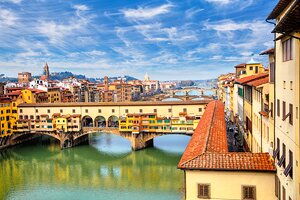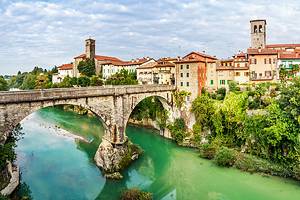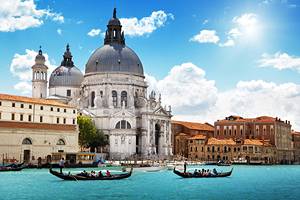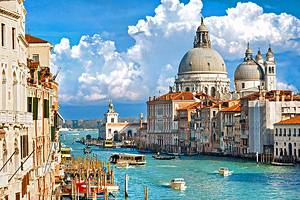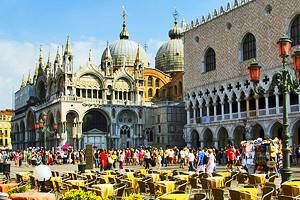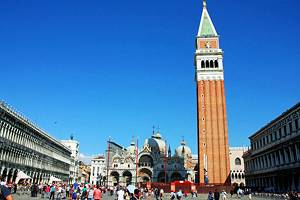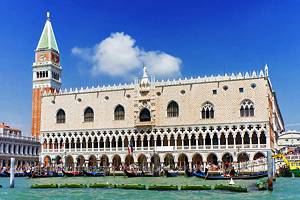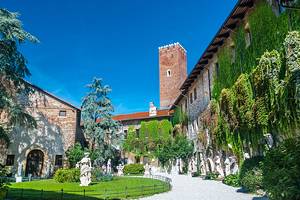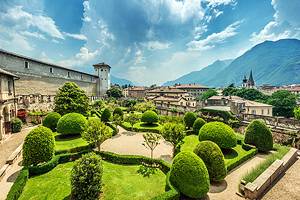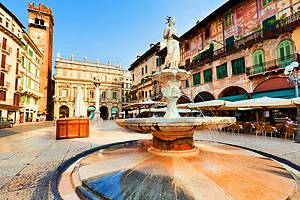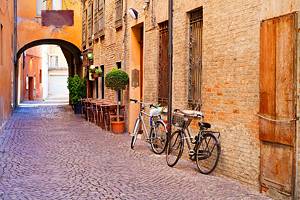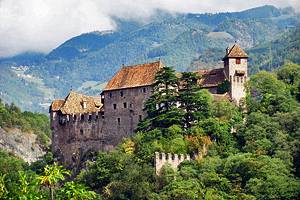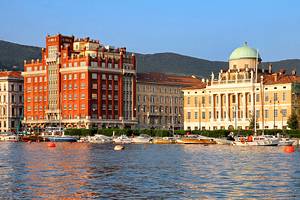Attractions & Things to Do in Treviso
Treviso, capital of the province of the same name, lies in the Veneto plain, 20 kilometers north of Venice. It's often called one of the "Little Venices" for its canals with buildings rising straight from the water, as well as for the distinctly Venetian lions on its gates.

But you would never mistake Treviso's vine- and flower-draped canals or its candy-colored buildings for Venice, even though a modern wall decoration depicts a gondola prow and gondolier. Treviso is its own place, and a thoroughly charming one at that.
This is an old-world town of narrow streets, many of them lined with arcades, and it is still surrounded by well-preserved 15th-century walls. The canals and walls make it a pleasant town to stroll through and admire the many frescoes decorating house façades.
Although badly damaged by World War II bombing, Treviso's art-filled churches have been remarkably well restored and are worthwhile tourist attractions. You can see frescoes by medieval master Tommaso da Modena in several of them. Learn more about the best places to visit in and around the city with our list of the top tourist attractions and things to do in Treviso.
- Piazza dei Signori
- Cathedral and Museo Diocesano
- Loggia dei Cavalieri
- City Walls and Gates
- Civic Museums: Luigi Bailo and Santa Caterina
- San Nicolò
- Canals and Water Mills
- Visit Villa Emo
- Bike or Walk along the Sile River
- Pescheria (Fish Market)
- Indulge your Inner Foodie
- San Francesco
- Castelfranco
- Watch the Sunset in Conegliano
- A Day Trip to Venice
- Map of Attractions & Things to Do in Treviso
Piazza dei Signori

In the center of Treviso is the picturesque Piazza dei Signori with the Palazzo dei Trecento, built in the 1300s and once the seat of Treviso's government, and the 15th-century Palazzo del Podestà with the tall Torre del Comune.
The Palazzo Pretorio, a Renaissance palace, now houses the town council. Between Piazza dei Signori and Piazza del Duomo runs Via Calmaggiore, Treviso's main street, lined by fine 15th- and 16th-century houses. Although only three blocks long, it has a number of buildings with decorated facades and lunettes above their arched doorways. On Treviso's market days, you'll find the square filled with stalls and shoppers.
Backing onto Piazza dei Signori but facing Piazza San Vito is the church of Santa Lucia, where the saint's relics rest. Although not at all prepossessing from the outside, it has a lovely peaceful interior with frescoed ceilings and remains of medieval frescoes on the walls. Treviso's tourist information office is in the little Piazza Monte di Pietà, just behind Piazza dei Signori.
Cathedral and Museo Diocesano

The five-domed cathedral of San Pietro was built in the 15th and 16th centuries on the site of an earlier Romanesque church. Below it is the crypt of the original church, dating from the 11th and 12th centuries; the porch was added in 1836. Inside the cathedral, look for The Annunciation by Titian, painted in 1517, and the frescoes by Pordenone, completed in 1520.
The Cappella del Sacramento is decorated with excellent examples of sculptures by Pietro and Tullio Lombardo and by L. Bregno. To the left of the cathedral stands the Romanesque Baptistery from the 11th and 12th centuries, with 13th-century frescoes and a fine font.
Portions of a mosaic floor from a paleochristian baptistery have been exposed on Via Canonica, where there is also the Museo Diocesano d'Arte Sacra di Treviso (entered through the cathedral), containing sacred art and archaeological finds.
Address: Piazza del Duomo
Loggia dei Cavalieri

On Via Martiri della Libertà, not far from Piazza dei Signori, the striking Loggia dei Cavalieri (Lodge of Knights) was built in 1276 as a meeting place for the nobility. The location was perhaps symbolic of the importance and power of the nobles who met there, as this is thought to have been the site of the ancient Roman Forum.
The roof of the open loggia is supported by stone columns, and the interior was originally covered in frescoes. These were overlaid by later frescoes in the 1300s, of which some remain. The loggia is still used for public events, and is one of the most photographed attractions in Treviso.
City Walls and Gates

The well-preserved 15th-century walls that surround Treviso are not the first; Treviso was a Roman city, and the Romans fortified it from the earliest days. The River Sile flows alongside the walls, and together with the River Cagnan, it was used to further protect Treviso from attack.
The waters were diverted into canals that encircled the city and were designed so they could also be used to flood the surrounding lowlands, making a siege difficult. The present walls, strengthened by earthworks, were built by the Venetians, as you can guess from the winged lions on the imposing gates. Treviso was Venice's major stronghold protecting it from invasions from the north.
Take time to walk alongside the walls, or at least to see the three major gateways into the city, Porta San Tommaso, Porta Santi Quaranta, and Porta Altinia. From Porta San Tommaso, built in 1518 at the northeast corner of Treviso, you can walk along the northern rampart, where there are beautiful views of the Alps.
Civic Museums: Luigi Bailo and Santa Caterina
With the restoration of the building on Borgo Cavour, the collections of Treviso's Civic Museum are now housed in two separate complexes. The Luigi Bailo Civic Museum is dedicated to art of the late 19th and early 20th centuries and houses the largest existing collection of works by Arturo Martini, one of Europe's most important 20th-century sculptors.
The 14th-century former convent of Santa Catarina, long abandoned and badly damaged in World War II, has been restored and repurposed to display the museum's collections of medieval and Renaissance works. These include paintings by Bellini, Titian, Cima da Conegliano, Lorenzo Lotto, Pisanello, Pordenone, and many other artists.
The highlight is Tommaso da Modena's best-known work: his fresco cycle depicting the life of St. Ursula. Painted in the 14th and 15th centuries and surprisingly lively and dynamic, these frescoes were moved here from the now-demolished church of Santa Margherita degli Eremitani.
Less famous, but a fascinating glimpse of Treviso in the late 19th century are the frescoes rescued from patrician homes, public buildings, and churches that were scheduled for demolition. In addition to art, the Santa Catarina complex displays impressive archaeological collections, including bronze swords dating back to 1600 BC.
Rounding off the Museo Civico holdings are three late-medieval buildings on Via Canova: Ca' da Noal, Casa Robegan, and Casa Karwath, now restored as home to changing exhibits of contemporary art.
San Nicolò

At the southwest corner of the old town, the Dominican church of San Nicolò is a spacious Gothic church built in brick during the 13th and 14th centuries. It has round piers and an unusual vaulted timber roof, which has been restored.
On the high altar is Madonna Enthroned by Fra Marco Pensaben and Savoldo from 1521, and the tomb of Senator Agostino Oningo is by master sculptors Pietro and Tullio Lombardi dating from 1490. The elaborate organ, completed in 1779, is by Gaetano Callido, and a nearby fresco represents St. Christopher.
But the frescoes in the chapterhouse of the former monastery are especially impressive. Wrapping around the room is a frieze of 40 fresco portraits of Dominicans by Tommaso da Modena, painted in 1352.
What makes them so outstanding, even in this city where there are so many examples of his work, is their personality, even humor. Each friar is shown at work, engaged in mundane duties at his desk, and the liveliness and individuality of their portrayal is surprising for its day, even for a follower of Giotto, as Tommaso was.
Address: Via San Nicolò, Treviso
Canals and Water Mills

Two rivers encircle Treviso, and in addition to their confluence here, their waters have been contained into a series of canals and tiny waterways that wander picturesquely through the city. Houses rise directly from their water, and it flows under the arched foundations of others.
Each bridge reveals another vignette of balconies above the water. Adding to all this is an occasional waterwheel, a remnant of those that once drove mills throughout the city. You'll see them as you walk around Treviso, but there is one quite near the Pescheria, the fish market.
Visit Villa Emo

One of the great architect Andrea Palladio's most spacious villas, the 16th-century Villa Emo was also a statement of social change, incorporating all the business of the great agricultural estate (the family made its fortune growing corn for polenta) under one roof, from the life of the family to the work done by farm laborers.
Giovanni Battista Zelotti painted the interior frescoes of mythological and agricultural scenes, which glorify hard work and rural life. Look for the playful use of trompe l'oeil to simulate architectural elements that appear to frame the scenes.
Address: Via Stazione 5, Fanzolo di Vedelago, Treviso
Bike or Walk along the Sile River

One of the most popular things to do in Treviso, for both locals and tourists, is walking or cycling through the Natural Regional Park along the Sile River. The park protects more than 10,000 acres of meadow, wetlands, and river.
You can follow the river in either direction, passing villas, settlements, even the Cimitero dei Burci, a "cemetery" of old commercial boats that once used the river for trade. They were abandoned and sunk here in protest when the river was closed to navigation.
Pescheria (Fish Market)

One of the oldest and least changed quarters in Treviso includes the colonnaded buildings of the Buranelli and the convent of the Camaldolese nuns. Until the mid-1800s, there were three small islands in its midst, where fishermen from Burano brought their fish to sell. Then the three islands were joined, and a proper fish market was built on its own little island.
Surrounded as it is by elegant old buildings, this bustling morning market is one of the city's most atmospheric sights. More recently, some incongruous but attractive contemporary sculptures of fish and a mermaid have been added in the river.
Address: Via Pescheria, Treviso
Indulge your Inner Foodie

Treviso claims to be the place where Tiramisù originated, and although other cities make the same claim, it is still a good excuse to stop at a café and sample the delectable treat at least once.
The name itself seems to substantiate the claim, as it comes from the Treviso dialect, "Tireme su," meaning "pick-me-up."
San Francesco

The mix of Romanesque and Gothic features in this church hints at its origin in the 13th century, when Gothic was beginning to replace the older, heavier Romanesque. Hence its rounded transept and entrance arches and lighter sleeker arches of the windows and some chapels. History has not treated the church kindly.
Like many others in Treviso, it was commandeered by the French army when they took control of Venice and Treviso in 1797, robbed of its art, and used as a military storehouse. The monastery was demolished, and it was robbed of its cloisters, and a house was built with the bricks of two cloisters.
The church floor was removed, and the interior was divided into several floors to create more storage space. What's amazing is how much has survived. Inside the restored church is the 1364 tomb of Dante's son, Pietro Alighieri, a coffered timber ceiling, and in the altar to the left of the main altar, a Madonna and Child, with the saints painted by Tommaso of Modena.
Address: Viale San Antonio, Treviso
Castelfranco

One of the most photogenic places to visit around Treviso is the fortified medieval town of Castelfranco, about 30 kilometers to the west. Only half an hour by train, it makes an easy afternoon excursion.
Castelfranco's defensive walls, built in the late 1100s to defend the town from Padua, rise picturesquely above a moat. You can walk around the walls and moat, and for a good view of the entire set of fortifications - and the town - climb the 43-meter-tall Torre Civica, which has historic displays at its various levels.
Inside the walls, the masterpiece Madonna and Child by Italian Renaissance artist Giorgione hangs in the cathedral. Giorgione, whose house you can visit in Castelfranco, was the teacher of Titian, whose reputation soon grew to surpass his teacher's.
Watch the Sunset in Conegliano

Only 25 minutes north of Treviso by train, Conegliano is one of the most appealing towns in the Veneto. It climbs a hillside in three terraces before reaching the walled Castelvecchio at its summit. In its tower is a museum of frescoes and paintings, as well as a restaurant and sweeping views of the rolling countryside.
A cobblestone path connects the castle to the town below, its arcaded streets filled with palaces from the 15th century and later. Here, you'll find several churches of note, including the cathedral and the adjacent Scuola di Santa Maria dei Battuti, lined with an unusual cycle of 15th- and 16th-century frescoes.
Conegliano makes a good day or afternoon excursion from Treviso. You can go in the late afternoon, watch the sunset over dinner at the restaurant in the castle, and have plenty of time to catch a train back to Treviso.
A Day Trip to Venice

It's so easy to get to Venice, only about 35 minutes from Treviso by bus, that many tourists choose to stay here and "commute" to the city. In fact, Treviso airport is often used by low-cost airlines as an alternative to Venice's Marco Polo airport.
You'll arrive at either Santa Lucia train station or Porta Roma, both at the end of the Grand Canal. The vaporetto, Venice's water-born transit system, will take you the full length of the canal; past the elegant palaces; under Rialto Bridge; and to St. Mark's Square, where you'll find the city's two main tourist attractions, Basilica San Marco and the Doge's Palace.
Map of Attractions & Things to Do in Treviso
More Related Articles on PlanetWare.com

Places to Visit near Treviso: Intrigued by Treviso's lions and other traces of its days as part of the Venetian Republic? You'll find more reminders of Venice in the attractions of nearby Padua and in the charming towns that scatter the foothills of the Dolomites. This is also where you'll find some of Italy's best ski resorts. Villa Elmo is only the beginning of the splendid villas in this region, many of them designed by 16th-century Italian architect, Andrea Palladio, whose villas are among the top tourist attractions in Vicenza.

Exploring More of Northern Italy: Traces of Venice reach across much of northern Italy, through the historic streets of Verona, as you drive past the sites around beautiful Lake Garda, and as far as the hilltop town of Bergamo. Farther to the west are the villas and palaces of Lake Como, known for some of the most beautiful gardens in Italy. You'll find more ideas for your travels in PlanetWare's list of best places to visit in Italy.




